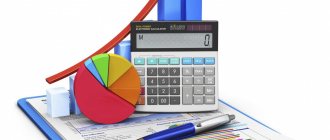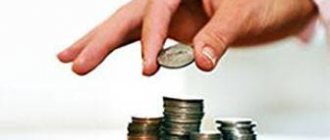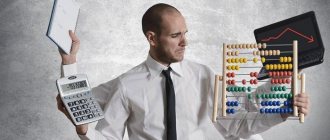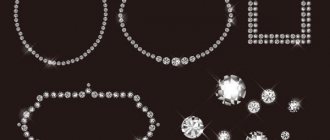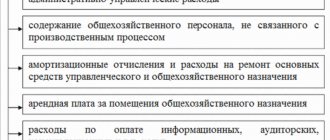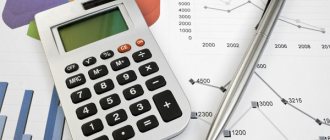What is account 20 in accounting
Account 20 is one of the registers in Section III of the Chart of Accounts. It summarizes information about the costs associated with the production of products (works, services).
Expenses
The main function of account 20 “Main production” is calculation, since it describes the economic process of manufacturing a product and collects all information about the costs of its production. Also, using an account card, you can track information about the movement of property in the enterprise.
The difference between this register and the others in accounting is that its balance at the end of the reporting period is not calculated using a formula, but is entered manually. This is due to the fact that cost information is collected on the account over a period of time (at least a month). Until the end of the period, the exact cost of the goods is unknown, since it includes many components - depreciation, wages for workers and management, utilities, transportation costs.
Thus, at the end of the reporting period (and necessarily at the end of the year), the account. 20, like production shops, is subject to inventory to identify work in progress. After this, the amount spent on the production of finished products (actual cost) is calculated, which is written off using one of the methods adopted by the enterprise’s accounting policy.
Practical examples
Let's imagine a situation where a certain organization provides repair services. Thus, during the reporting period, repair services were provided, the total cost of which was 30,000 rubles, and the planned cost was 25,000 rubles.
The volume of production costs amounted to 27,000 rubles, including:
- material costs - 5,000 rubles;
- the amount of depreciation charges is 1,790 rubles;
- labor costs – 23,045 rubles.
In this case, the accounting entries will be as follows:
- costs of creating a product:
Dt 20
Kt 10 – 5,000 rubles, write-off of material costs for the production process;
- carrying out repair work:
Dt 62
Kt 90.01 – 35,400 rubles, sales revenue;
Dt 90.03
Kt 68 – RUR 5,400, value added tax charged;
Dt 90.02
Kt 20 – 25,000 rubles, the planned cost is written off;
- payroll for production workers:
Dt 20
Kt 70 – 20,000 rub.,;
Dt 70
Kt 68 – 2,600 rubles, income tax withholding;
Dt 20
Kt 69 – 3,045 rubles, withholding of insurance premiums.
- closing entries at the end of the reporting period:
Dt 90.02
Kt 20 – 2,000 rubles, correction of the cost of services provided.
What counts in the 20 count?
Account 20 is used to account for the following costs:
- production of products from agricultural and industrial enterprises, as well as subsidiary farms;
- costs of repair work, maintenance of cars and other vehicles;
- costs of organizations providing transport services;
- costs of construction, installation and design and survey work;
- costs of performing research and development work;
- costs of catering organizations;
- salaries of key and administrative personnel;
- depreciation of production equipment;
- amounts of payments for renting premises and paying for utilities;
- other expenses related to the activities of the production enterprise.
Debit 20 reflects all direct costs associated with the manufacture of products (performance of work and provision of services), costs of auxiliary production, indirect costs, as well as losses from defects. Credit 20 reflects the amount of the actual cost of goods, the production of which has already been completed, or work performed and services rendered.
Counting scheme 20
When determining the type of account 20 - whether it is active or passive - you need to understand the following: since the company cannot consume more raw materials and materials than it was written off for, therefore, debit turnover on the account. 20 will always be more credit. And this means that the count. 20 - active. Balance (remaining) according to account. 20 at the end of the month reflects the amount of work in progress costs.
What is reflected in debit and credit
The debit of account 70 shows:
- Amounts of paid salaries, bonuses, benefits, and other cash payments to the employee;
- Amounts of accrued taxes, fees, deductions under writs of execution, etc.
- Amounts of accrued but not paid wages on time.
The account credit reflects:
- The amount of salary that the employee earned for the specified period;
- Amounts of earnings that were accrued from reserves;
- Amounts of accrued benefits - sick leave, maternity leave, etc., paid from social insurance funds;
- Amounts of income from participation in the capital of the organization.
How to close
Closing of account 20 occurs when the production of products is completed, work is performed or services are provided. To close the account, it is necessary to reflect it in the accounting entry for a loan for the amount of goods produced. Thus, after closing the account, it can either be reset to zero (if there are no other work in progress) or remain with a debit balance (if there is still work in progress).
Note! Account lending 20 does not always mean production is complete. If a defect is detected, it is also written off from credit 20 to debit 28 “Defects in production”.
Current legislation provides for the possibility of closing an account. 20 in one of three ways: direct, intermediate or direct implementation. The characteristics of the closing method must be spelled out in the accounting policy of the enterprise, and immediately before closing, the accountant must highlight the balances of work in progress, if any.
Direct method
This method is used when the actual price of manufactured products is unknown during the reporting period, so they are accounted for at conditional prices, mainly at planned costs. In the process of closing the account. 20 accounting department adjusts the cost of manufactured products to the actual cost.
With this closing method, accounting makes the following entries:
- Dt43 Kt20 - finished products are transferred to the warehouse at the planned cost;
- Dt90-02 Kt43 - writing off deviations of actual and planned cost to cost of sales.
Attention! When using this closing method, it becomes impossible to take into account the actual price of products during the month.
Intermediate method
When using this method, an account is additionally used in accounting. 40 “Product release”. This account reflects deviations of the planned cost from the actual one, while credit 40 includes the planned cost, and debit the actual cost.
Intermediate method of closing an account. 20
At the end of the reporting period, the total amount of the difference is written off proportionally to the account. 43 and 90-02. During the month, the accountant makes the following entries:
- Dt43 Kt40 - capitalization of finished products at planned cost;
- Dt90-02 Kt43 - write-off of sold products at planned cost.
How to close account 20 at the end of the month:
- Dt40 Kt20 - write-off of the actual cost of manufactured products;
- Dt43 Kt40 and Dt90-02 Kt40 are adjusting entries that bring the planned cost to the actual cost.
Direct implementation
This method of closing an account. 20 applies when the manufactured goods are not stored in a warehouse, but are immediately sold by the buyer. In this case, the costs are immediately written off to the cost of sales - Dt90-02 Kt20.
Subaccounts
For account 20 the following recommended sub-accounts can be opened for the main activities of the enterprise:
- 20-01 “Crop production”. This takes into account the costs of crop production and its branches - horticulture, floriculture, growing seedlings.
- 20-02 “Livestock” - accounting for the costs of output from livestock farming and its industries - dairy and beef cattle breeding, sheep farming, fish farming, beekeeping, etc.
- 20-03 “Industrial production”. This subaccount reflects all direct costs associated with the manufacture of goods, preparation and development of production, other production costs, as well as production maintenance and management costs.
- 20-04 “Other main production” - cost accounting for other main activities of manufacturing enterprises.
Analytical monitoring
Analytical analysis of auxiliary production is carried out in the following main categories:
- Types of production activities, the provision of which is carried out (subconto “Divisions”);
- Types of work performed, services, manufactured products (“Nomenclature groups”);
- Types of costs (sub-account “Cost Items”).
To organize a clear monitoring system for the activities of auxiliary production, it is necessary to obtain timely information about the cost of products, work and services performed. Violation of the organization of the analytical monitoring process can lead to unreliable information in the financial statements submitted to regulatory authorities.
Attention! For a small volume of auxiliary production work, it is permissible to attribute costs directly to ensuring the organization’s core activities and management.
Interaction with other accounts
Account correspondence 20 on debit is carried out with the following sections:
- Section 1 - 02, 04, 08.
- Section 2 - 10, 11, 16.
- Section 3 - 20, 21, 23, 25, 26, 28, 29-3.
- Section 4 - 40, 41, 43.
- Section 6 - 60, 68, 69, 70, 71, 73, 75, 76, 79.
- Section 8 - 94, 96.
On loan account 20 interaction with other accounts is carried out as follows:
- Section 2 - 1, 11.
- Section 3 - 21, 28.
- Section 4 - 40, 43.
- Section 6 - 76, 79.
- Section 8 - 90, 91, 94, 99.
Account postings 20
All transactions performed under debit 20 show the accrual, reflection and accounting of the cost of all materials and costs of manufacturing products.
Typical wiring
The correspondence with Section 1 reflects the inclusion of depreciation costs in the cost of production:
- Dt20 Kt02 - for products used in primary production and trade;
- Dt20 Kt04 - for depreciation of intangible assets;
- Dt20 Kt08 - construction costs are reflected.
Correspondence with Section 2 reflects the write-off of the cost of materials:
- Dt20 Kt10 - the cost of materials written off for main production is taken into account;
- Dt20 Kt11 - write-off of the cost of animals for the main production is taken into account;
- Dt20 Kt16 - writing off the amount of deviations in the cost of materials.
The correspondence with Section 3 reflects the inclusion in the cost of other types of expenses:
- Dt20 Kt20 - intra-production turnover of products;
- Dt20 Kt21 - transfer of self-made semi-finished products to the main production;
- Dt20 Kt23 - inclusion in the cost price of the cost of services of auxiliary production;
- Dt20 Kt25 - inclusion of overhead costs in the cost of production;
- Dt20 Kt26 - inclusion of general business expenses in the cost of production;
- Dt20 Kt28 - inclusion in the cost of losses from defects;
- Dt20 Kt29 - inclusion in the cost of production the cost of services of service industries and farms.
Correspondence with Section 4 occurs as follows:
- Dt20 Kt40 - write-off of planned cost;
- Dt20 Kt41 - transfer to the main production of goods purchased for sale;
- Dt20 Kt43 - supply of finished products for the needs of the main production.
Correspondence with Section 6 occurs as follows:
- Dt20 Kt60 - payment to third parties for services provided for the main production;
- Dt20 Kt68 - inclusion of taxes and fees in the budget in the cost of production;
- Dt20 Kt69 - calculation of insurance premiums for employees of the main production;
- Dt20 Kt70 - payroll;
- Dt20 Kt71 - payment of expenses of accountable persons for the needs of the main production;
- Dt20 Kt73 - inclusion of compensation for wear and tear of personal property in the cost of production;
- Dt20 Kt75 - contribution of the main production costs by the founders of the enterprise;
- Dt20 Kt76 - inclusion of insurance costs in the cost price;
- Dt20 Kt79 - inclusion of separate production costs in the cost price.
Correspondence with Section 8 occurs as follows:
- Dt20 Kt94 - inclusion in the cost price of the amount of identified shortages for various reasons (from damage to property, based on inventory results);
- Dt20 Kt96 - accrual from the cost of production of amounts to the reserve for future expenses (for repairs, vacation pay).
Note! Entries for credit 20 reflect the receipt of materials, waste, and finished products from the main production.
The relationship with Section 2 reflects the return of materials and supplies from main production:
- Dt10 Kt20 - taking into account unused materials and waste.
- Dt11 Kt20 - increase in the cost of animals due to weight gain.
Correspondence with Section 3 accounts occurs as follows:
- Dt21 Kt20 - receipt of self-made semi-finished products from the main production;
- Dt28 Kt20 - reflection of losses in the cost of irreparable defective products.
Correspondence with Section 4 accounts:
- Dt40 Kt20 - write-off of the actual cost of manufactured products;
- Dt43 Kt20 - posting of finished products.
Capitalization of finished products
The relationship with the accounts of Section 6 reflects:
- Dt76 Kt20 - reduction in the cost of work in progress;
- Dt79 Kt20 - performance of work by the main production.
Correspondence with Section 8 occurs as follows:
- Dt90 Kt20 - write-off of actual cost;
- Dt91 Kt20 - write-off of works or services of the main production;
- Dt94 Kt20 - reflection of the amounts of shortage of work in progress identified during the inventory process;
- Dt99 Kt20 - the costs of the main production are attributed to the losses of the enterprise.
Basic business operations
- Depreciation
Dt 23 Kr 02 – fixed assetsDt 23 Kr 05 – NMA;
- Write-off of inventory items
- Semi-finished products
Dt 21 Kr 23 – capitalization;Dt 23 Kr 21 – write-off
- Displaying the share of costs attributable to ancillary production activities
Dt 23 Kr 25 - productionDt 23 Kr 26 – household
- Settlements with employees
Dt 23 Kr 70 – for wagesDt 23 Kr 76 – insurance costs
- Displaying the cost of work performed
Dt 44 Kr 23 - as part of commercial costs;Dt 90 Kr 23 - as part of sales made;
Dt 91 Kr 23 – sale and disposal of fixed assets
- Display of identified shortages
- Detection of manufacturing defects
Victor Stepanov, 2016-12-21
